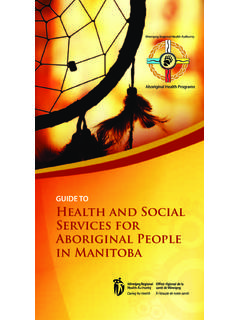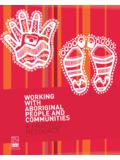Transcription of Health Inequalities and Social Determinants of Aboriginal ...
1 Health Inequalities and Social Determinants of Aboriginal Peoples' Health Sharing knowledge. Making a difference. Charlotte Loppie Reading University of Victoria Fred Wien Dalhousie University 3333 University Way, Prince George, V2N 4Z9. Tel (250) 960-5986 Fax (250) 960-5644 Email: 2009. National Collaborating Centre for Aboriginal Health Centre de Collaboration Nationale de la Sant Autochtone Health Inequalities and Social Determinants of Aboriginal Peoples' Health Charlotte Loppie Reading Fred Wien University of Victoria Dalhousie University 2009.
2 Table of Contents Health Inequalities and Social Determinants of Aboriginal Peoples' Health 1. Introduction 1. Social Determinants of Aboriginal Health 1. Socio-Political Context 2. A Holistic Perspective of Health 3. Life Course Child, Youth and Adult 3. A Note on the Adequacy of Aboriginal Public Health Data 4. Proximal Determinants of Health 5. Health Behaviours 6. Physical Environments 8. Employment and Income 9. Education 12. Food Insecurity 14. Intermediate Determinants of Health 15. Health Care Systems 15.
3 Educational Systems 17. Community Infrastructure, Resources and Capacities 17. Environmental Stewardship 17. Cultural Continuity 18. Distal Determinants of Health 20. Colonialism 21. Racism and Social Exclusion 22. Self-Determination 23. Conclusion 24. Putting It Together: The Integrated Life Course and Social Determinants Model of Aboriginal Health (ILCSDAH) 25. Appendices 27. References 33. Table Sources 40. List of Tables table 1 The Well-Being of Inuit, First Nation and Other Canadian Communities, 2001 6.
4 Table 2 Self-reported Smoking by First Nation Adults on Reserve, by Aboriginal Adults Off-Reserve, and by Non- Aboriginal Adults in Canada 7. table 3 Mothers Smoking During Pregnancy, First Nation on Reserve and Canada, 2002 03 (percent) 7. table 4 First Nation Adults on Reserve Who Live in a Smoke-Free Home, 2002 03 7. table 5 Repairs Required for Dwellings Located On Reserve (2002 03) and for Canada (2003) 8. table 6 Percentage of Inuit, M tis, First Nation and Non- Aboriginal People Living in Crowded Dwellings, Canada, 2006 9.
5 Table 7 Selected Labour Force Characteristics for the Aboriginal Identity Population in Canada, 15 Years and over, 2001 Census 10. table 8 Selected Income Characteristics of the Aboriginal Identity Population in Canada, 15 years of Age and over, 2001 Census 10. table 9 Percentage of Those Reporting Fair or Poor Health by Household Income among Off-reserve Aboriginal and non- Aboriginal Peoples, Canada, 2000/01 11. table 10 Percentage of Those Experiencing a Major Depressive Episode in the Past Year by Household Income and Off-reserve Aboriginal Status, Canada, 2000/01 12.
6 Table 11 Highest Level of Schooling Attained by the Aboriginal Identity Population in Canada, 15 years of age and over, 2001 Census 13. table 12 Prevalence of Food Insecurity, by Level and Selected Characteristics, Household Population, Canada Excluding Territories, 1998 99 (Percent) 14. table 13 Health Care Utilization and Access, Household Population Aged 15. or Older, by Off-reserve Aboriginal Status, Canada and the Northern Territories, 2000 01 15. table 14 Barriers to Accessing Health Services, First Nation Adults Living On Reserve, 2002 03 16.
7 Table 15 Connection to the Land 18. table 16 Percentage of First Nations People Who Have Knowledge of an Aboriginal Language, by age groups, Canada 2001 and 2006 19. table 17 Percentage of Inuit Population who Reported Inuktitut as Mother Tongue and as Home Language, and Knowledge of Inuktitut, Canada and Regions, 1996 and 2006 19. table 18 Percentage of the M tis Population with Knowledge of an Aboriginal Language, by Age Groups, Canada, 2006 20. table 19 Percentage of First Nation Adults Living on Reserve Who Consider Traditional Spirituality and Religion Important in Their Lives 20.
8 Table 20 The Impact of Residential Schools on First Nation Adults Living on Reserve, 2002 03 22. table 21 Instances of Racism Experienced by First Nation Adults on Reserve and Perceived Impact on Level of Self-Esteem, 2002 03 23. table 22 Self-determination Indicators by Feelings of Depression and Sadness for First Nation Adults Living on Reserve, 2002 03 24. Appendixes table 23 Most Frequent Long-Term Health Related Conditions among First Nations Children Living On Reserve, 2002 03 27. table 24 Most Frequent Long-Term Health Related Conditions among First Nation Youth Living On Reserve, 2002 03 27.
9 Table 25 Frequently-Occurring Long-term Health Conditions of First Nation Adults Living on Reserve, and Other Adults in Canada 28. table 26 Body Mass Index, Household Population 15 years of Age 28. table 27 Adults 15 years of Age and Over Who Have Suffered a Major Depressive Episode in the Last 12 Months by Off-Reserve Aboriginal Status (Percent) 29. table 28 Percentage of First Nation Youth Living on Reserve who Report Feeling Sad, Blue or Depressed for Two Weeks or More in a Row 29. table 29 Importance of Keeping, Learning or Relearning an Aboriginal Language, by Age Group, M tis Identity Non-reserve Population 15 years of Age and Over, 2001 30.
10 Table 30 Who Helps Aboriginal Children Learn an Aboriginal Language (Canada, 2001) 30. table 31 Residential School Attendance for Aboriginal Adults Living Off-Reserve, and for First Nation Adults Living On Reserve 31. table 32 Residential School Attendance for Aboriginal Adults Living Off-Reserve, and for First Nation Adults Living On Reserve 32. National Collaborating Centre for Aboriginal Health Health Inequalities and Social Determinants of Aboriginal Peoples' Health Introduction This paper uses available data to describe Health Inequalities experienced by diverse Aboriginal peoples in The data are organized around Social Determinants of Health across the life course and provide evidence that not only demonstrates important Health disparities within Aboriginal groups and compared to non- Aboriginal people.









